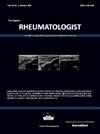Elbow joint involvement in rheumatoid arthritis patients: Clinical and ultrasound findings of the neglected joint
IF 1
Q4 RHEUMATOLOGY
引用次数: 0
Abstract
Aim
of the work.
To assess the role of musculoskeletal ultrasound (MSUS) in the evaluation of elbow joint abnormalities in rheumatoid arthritis (RA) patients.
Patients and methods
This study was conducted on 47 RA patients subjected to clinical assessment and MSUS of both elbows.
Results
The mean age of the patients was 44 ± 9.55 years, they were 42 females, and 5 males and rheumatoid factor was positive in 76.6 %. This work was conducted on 94 elbow joints (59.6 % asymptomatic, 8.5 % unilateral, and 31.9 % bilateral joint pain). Ultrasound (US) abnormalities were present in 61 (64.9 %) of scanned joints. Effusion/synovial hypertrophy was the most common abnormality (31.9 %), followed by structural abnormalities at the common extensor tendon (26.6 %). There was a significant difference between symptomatic and asymptomatic elbow joints regarding US abnormalities of the elbows. MSUS showed high sensitivity and specificity in detection of elbow pathology compared to physical examination as the following: biceps tendon pathology (98.81 % specificity, 40 % sensitivity), effusion/synovial hypertrophy (62.32 % specificity, 68 % sensitivity), lateral epicondylitis (71.43 % specificity, 76.47 % sensitivity), medial epicondylitis (71.95 % specificity, 66.67 % sensitivity), and triceps enthesopathy (73.33 % specificity, 50 % sensitivity). Moderate agreement was observed for biceps tendon pathology (κ = 0.5, p < 0.001). Fair agreement was noted for effusion/synovial hypertrophy (κ = 0.25, p = 0.009). Similarly, fair agreement was observed for lateral epicondylitis (κ = 0.34, p < 0.001) and medial epicondylitis (κ = 0.23, p = 0.008). Although triceps enthesopathy showed only slight to no agreement between clinical examination and US (κ = 0.06, p = 0.31).
Conclusion
Elbow problems are frequent among individuals with RA, even in those who do not exhibit overt elbow symptoms.
类风湿关节炎患者肘关节受累:被忽视关节的临床和超声表现
工作的目的。目的探讨肌肉骨骼超声(MSUS)在类风湿关节炎(RA)患者肘关节异常诊断中的作用。患者和方法本研究对47例RA患者进行了临床评估和双肘MSUS。结果患者平均年龄44±9.55岁,其中女性42例,男性5例,类风湿因子阳性占76.6%。这项工作对94个肘关节进行了研究,其中59.6%无症状,8.5%单侧,31.9%双侧关节疼痛。超声(US)异常存在于61(64.9%)扫描关节。积液/滑膜肥厚是最常见的异常(31.9%),其次是总伸肌腱的结构异常(26.6%)。有症状和无症状肘关节的US异常有显著差异。MSUS检测肘关节病变的灵敏度和特异性均高于体格检查:肱二头肌肌腱病变(特异性98.81%,敏感性40%)、积液/滑膜肥厚(特异性62.32%,敏感性68%)、外上髁炎(特异性71.43%,敏感性76.47%)、内上髁炎(特异性71.95%,敏感性66.67%)、肱三头肌骨髓炎(特异性73.33%,敏感性50%)。二头肌肌腱病理结果有中等程度的一致性(κ = 0.5, p <;0.001)。积液/滑膜肥厚的结果一致(κ = 0.25, p = 0.009)。同样,外上髁炎的结果也一致(κ = 0.34, p <;0.001)和内侧上髁炎(κ = 0.23, p = 0.008)。虽然三头肌骨骺病变在临床检查和US之间只有轻微或没有一致(κ = 0.06, p = 0.31)。结论:即使在没有明显肘部症状的RA患者中,肘部问题也很常见。
本文章由计算机程序翻译,如有差异,请以英文原文为准。
求助全文
约1分钟内获得全文
求助全文

 求助内容:
求助内容: 应助结果提醒方式:
应助结果提醒方式:


